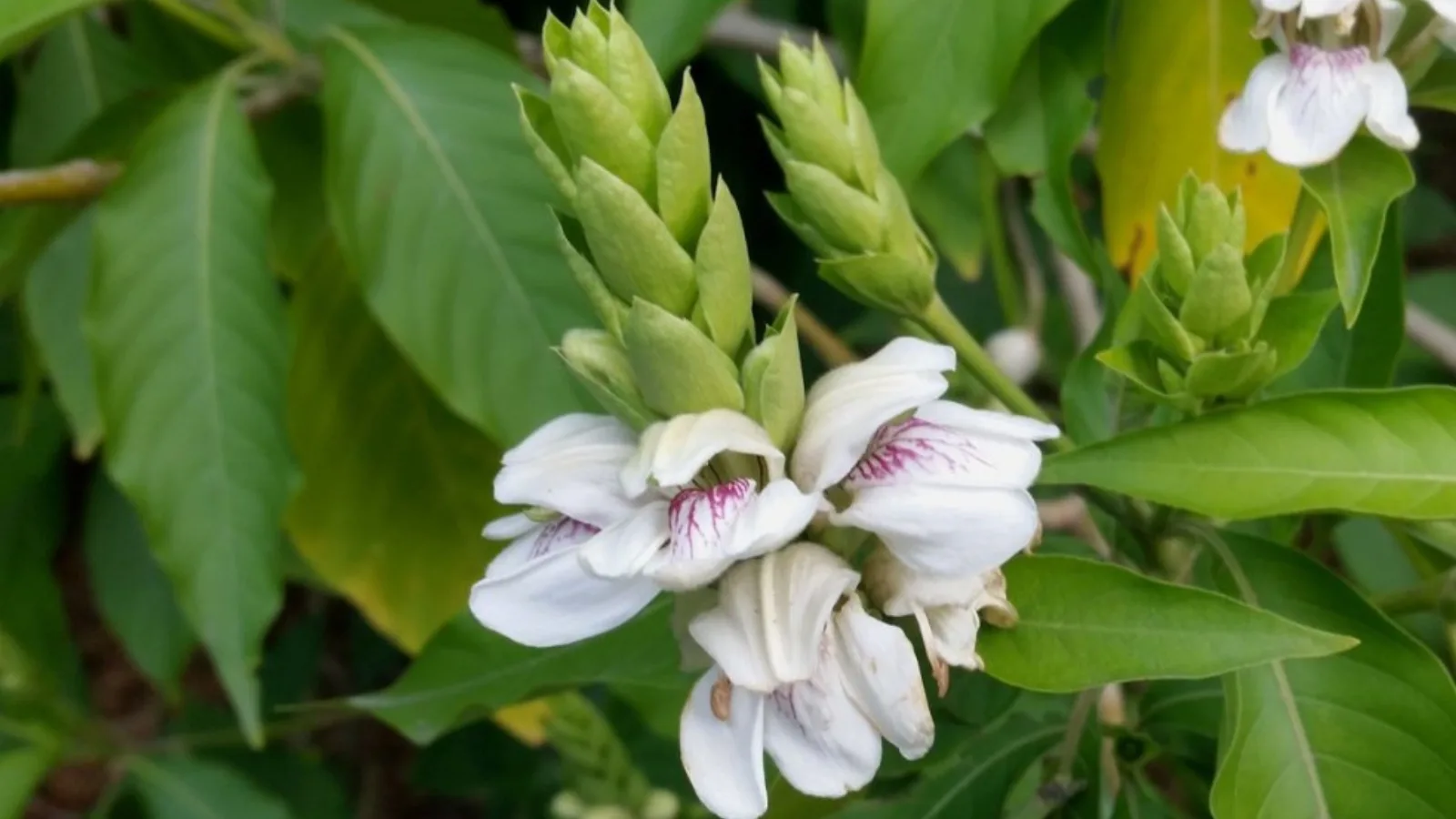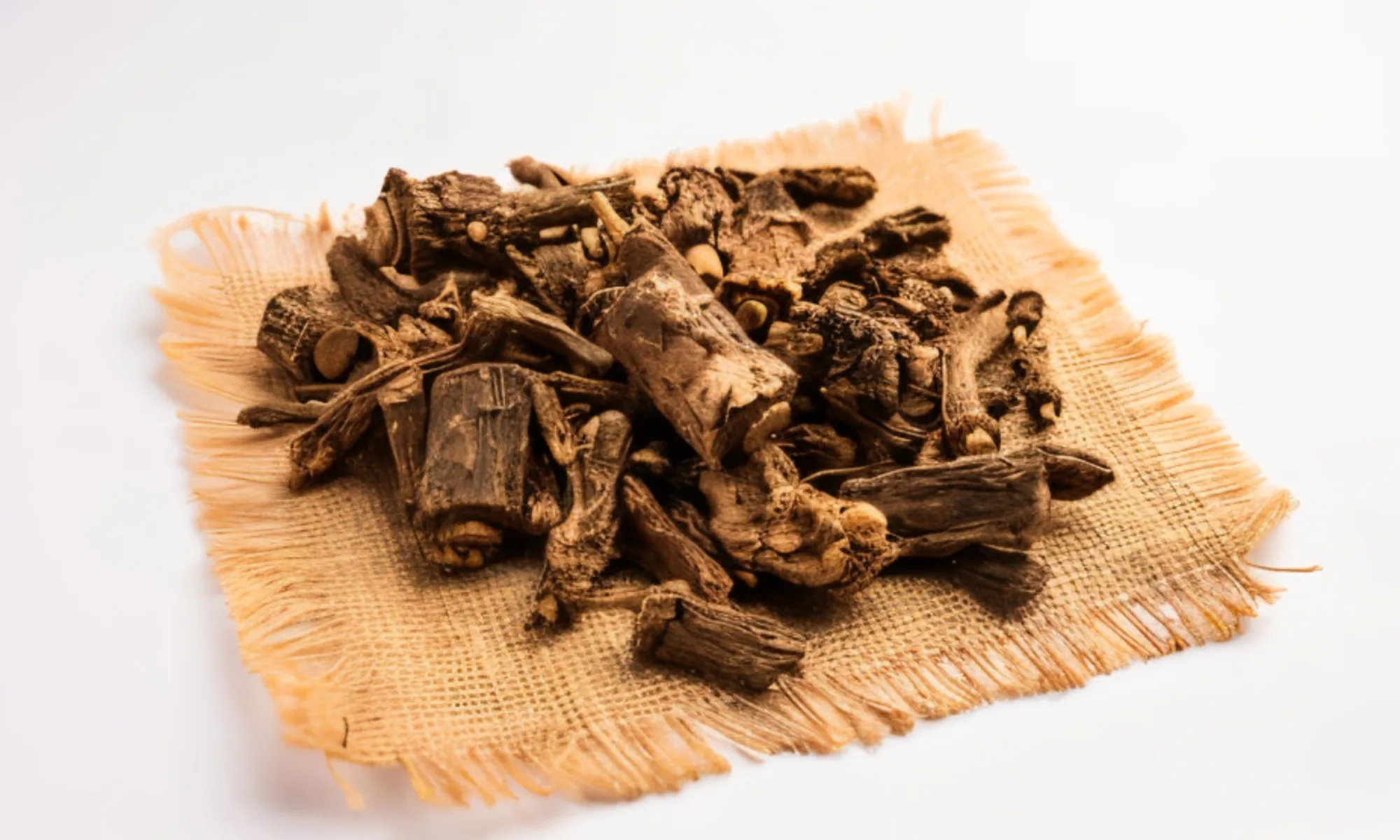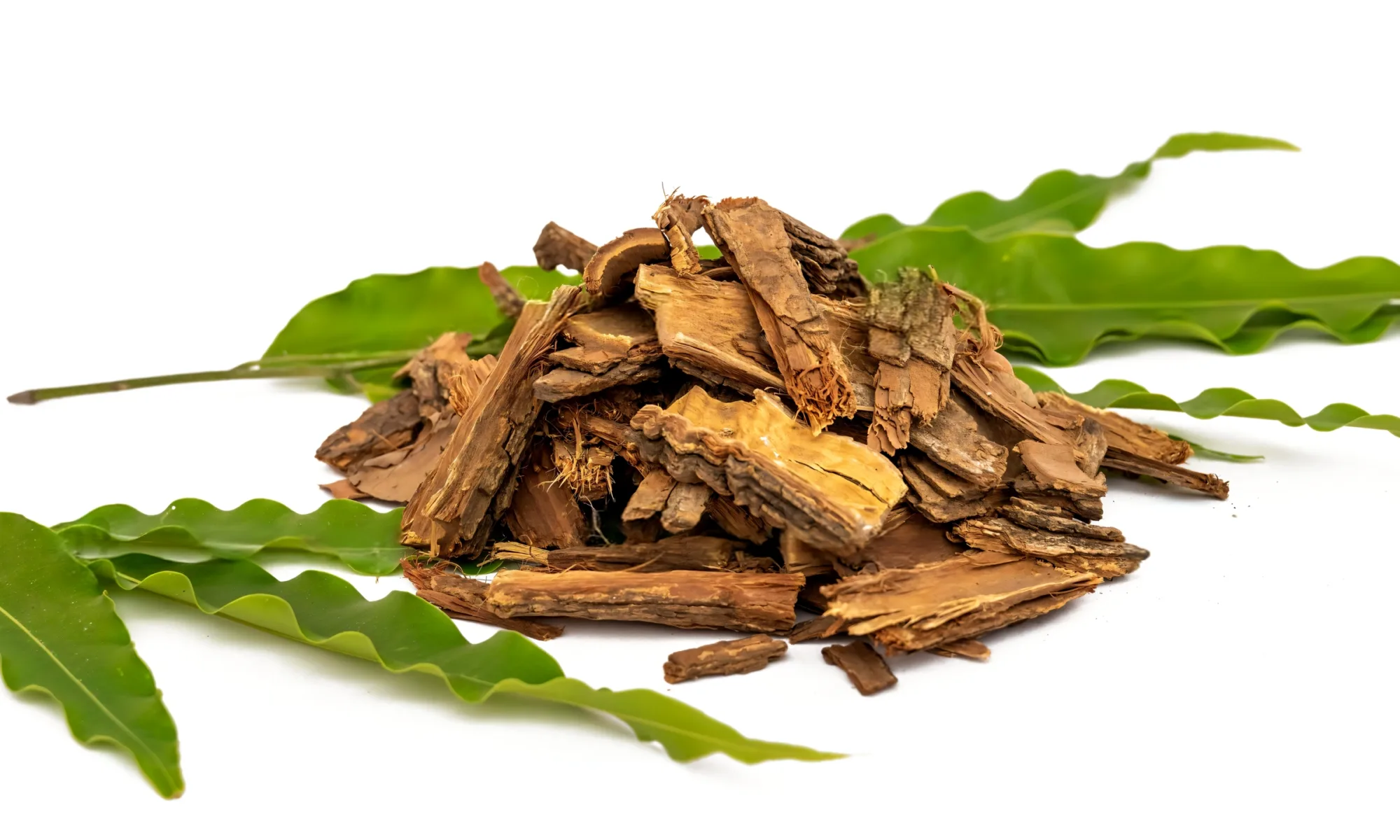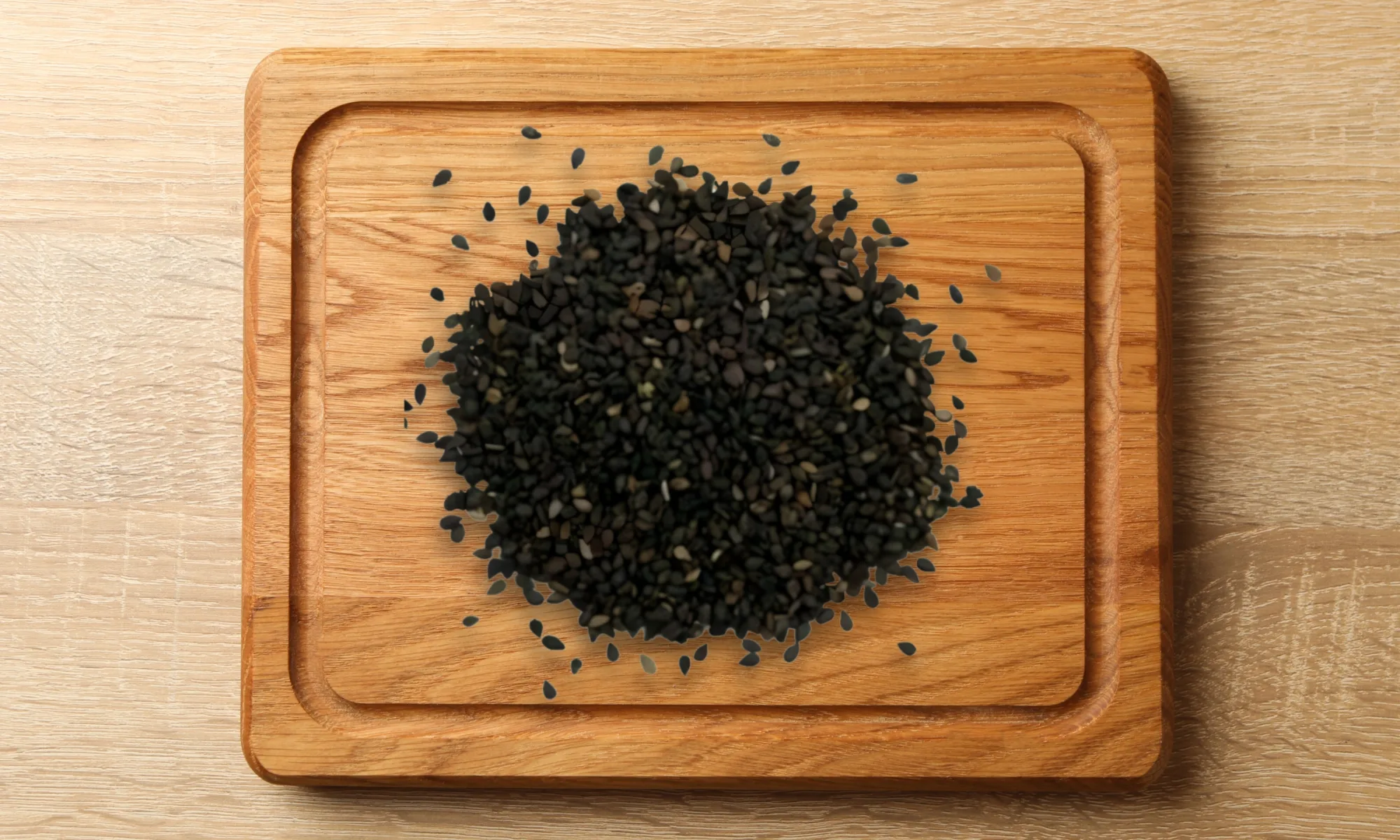
Kalmegh (Andrographis paniculata), commonly known as “King of Bitters,” is a medicinal plant extensively used in Ayurveda, Unani, Siddha, and traditional Chinese medicine. It is renowned for its bitter taste and potent anti-inflammatory, hepatoprotective, antipyretic, and immunomodulatory effects. The plant thrives in tropical and subtropical regions and is widely used in formulations aimed at treating fever, liver disorders, and infections.
Kalmegh Scientific Names
- Kingdom: Plantae
- Phylum: Angiosperms
- Class: Eudicots
- Order: Lamiales
- Family: Acanthaceae
- Genus: Andrographis
- Species: Andrographis paniculata
Andrographis paniculata Common Names
- English: Green Chiretta, King of Bitters
- Sanskrit: Kalmegha, Yavatikta
- Hindi: Kalmegh
- Tamil: Nilavembu
- Telugu: Nelavemu
- Malayalam: Kiriyath
- Kannada: Nelabevu
- Bengali: Kalmegh
- Marathi: Kirayata
Andrographis paniculata Uses
- Liver Health – Used as a hepatoprotective agent, treating jaundice, hepatitis, and fatty liver disorders.
- Antipyretic Action – Traditionally used for reducing fevers, including those caused by malaria, dengue, and viral infections.
- Immune System Support – Acts as an immunomodulator, enhancing the body’s defense mechanisms against infections.
- Anti-inflammatory and Antioxidant – Used in inflammatory conditions like arthritis due to its anti-inflammatory and antioxidant effects.
- Digestive Disorders – Aids in managing indigestion, intestinal worms, and appetite loss.
- Antimicrobial Properties – Possesses antibacterial, antiviral, and antifungal activity effective in respiratory and gastrointestinal infections.
Phytochemical Constituents
Kalmegh contains several bioactive constituents, primarily diterpenoid lactones and flavonoids, which are responsible for its therapeutic activities:
- Diterpenoids: Andrographolide, Neoandrographolide, Deoxyandrographolide
- Flavonoids: Apigenin, Luteolin
- Xanthones: Andrographidine A, B
- Polyphenols: Caffeic acid, Chlorogenic acid
- Others: Alkaloids, Saponins, Tannins
References
Ayurvedic Pharmacopoeia of India, Part I, Volume II, Govt. of India, Ministry of AYUSH.
Nadkarni, K.M. (1976). Indian Materia Medica, Vol. 1, Bombay Popular Prakashan.
Trivedi, P.C. (2006). Medicinal Plants: Ethnobotanical Approach, Agrobios.
Mishra, S.K., Sangwan, N.S., & Sangwan, R.S. (2007). “Andrographis paniculata (Kalmegh): A review.” Pharmacognosy Reviews, 1(2), 283–298.
Akbar, S. (2011). “Andrographis paniculata: A review of pharmacological activities and clinical effects.” Alternative Medicine Review, 16(1), 66–77.
World Health Organization (WHO). Monographs on Selected Medicinal Plants, Vol. 2, WHO, Geneva.
Chinese Pharmacopoeia Commission (2015). Pharmacopoeia of the People’s Republic of China.
European Medicines Agency (EMA). (2009). “Assessment report on Andrographis paniculata (Burm.f.) Nees, herba.” Committee on Herbal Medicinal Products.

Leptadenia reticulata (Retz.) Wight & Arn., commonly known as Jivanti, is a perennial twining shrub belonging to the Apocynaceae family. It is esteemed in Ayurveda for its rejuvenating and revitalizing properties. Traditionally, it has been used to treat a variety of ailments, including tuberculosis, emaciation, fever, and respiratory disorders. The plant is also recognized for its lactogenic effects, enhancing milk production in nursing mothers.
Jivanti Scientific Names
- Kingdom: Plantae
- Clade: Tracheophytes
- Clade: Angiosperms
- Clade: Eudicots
- Order: Gentianales
- Family: Apocynaceae
- Genus: Leptadenia
- Species: Leptadenia reticulata
Leptadenia reticulata common names
- English: Cork Swallow-Wort
- Sanskrit: Jivanti, Jivaniya, Hemalata, Payasvini
- Hindi: Dori, Meethi Dodi
- Marathi: Dodi, Khaandodkee
- Tamil: Paalai Keerai
- Telugu: Guttipaala
- Malayalam: Atakodiyan
- Kannada: Bugudi Hoovina Gedde
Jivanti Uses
- Respiratory Health – Used in treating cough, dyspnea (shortness of breath), and asthma.
- Digestive and Metabolic Support – Beneficial in managing emaciation, fever, and dysentery.
- Eye Health – Traditionally used to improve vision and treat night blindness.
- General Vitality – Acts as a rejuvenator, improving overall strength and immunity.
Phytochemical Constituents
Leptadenia reticulata contains a variety of bioactive compounds contributing to its therapeutic effects:
- Steroids: β-sitosterol, stigmasterol
- Flavonoids: Luteolin, diosmetin, rutin, apigenin
- Triterpenes: α-amyrin, β-amyrin, simiarenol
- Phenolic Compounds: Ferulic acid
- Alkaloids: Reticulin, deniculatin, leptaculatin
- Others: Hentricontanol
References
Sharma, R., & Singh, R. (2017). Leptadenia reticulata (Retz.) Wight & Arn. (Jivanti): A Review on Its Phytochemical and Pharmacological Profile. Journal of Pharmacognosy and Phytochemistry, 6(3), 123-129.
Sulaiman, C. T., Jyothi, C. K., Unnithan, J. K., & Balachandran, I. (2021). Phytochemical comparison and evaluation of anti-inflammatory and anti-diabetic activity of three source plants of Jivanti—an important Ayurvedic drug. Future Journal of Pharmaceutical Sciences, 7(1), 52.
Rajput, T. A. (2019). A Study on the Phytochemical Properties of Leptadenia Reticulata. Journal of Advances and Scholarly Researches in Allied Education, 16(5), 1323-1328.
Ayurvedic Pharmacopoeia of India. (2001). Part I, Volume III. Government of India, Ministry of Health and Family Welfare, Department of Indian Systems of Medicine & Homoeopathy.
Acharya, R., & Naik, R. (2018). Comparative nutritional evaluation of four botanical source plants of Jivanti: A classical Ayurvedic drug. Journal of Ayurveda and Integrative Medicine, 9(2), 123-129.

Pashanbhed (Bergenia ligulata) is a widely recognized healing herb in Ayurveda and other traditional medicine systems. The name “Pashanbhed” literally translates to “stone-breaker,” reflecting its traditional use in the treatment of urinary stones and kidney disorders. It is a perennial herb that grows in the Himalayan region and is valued for its diuretic, antiurolithiatic, and anti-inflammatory properties.
Pashanbhed Scientific Names
- Kingdom: Plantae
- Phylum: Angiosperms
- Class: Eudicots
- Order: Saxifragales
- Family: Saxifragaceae
- Genus: Bergenia
- Species: Bergenia ligulata
Bergenia ligulata Common Names
- English: Rockfoil, Stone-breaker
- Sanskrit: Pashanbheda, Ashmabhid
- Hindi: Pashanbhed
- Marathi: Pashanbhed
- Tamil: Sirupulai
- Kannada: Ashmabhedi
- Bengali: Patharkuchi
PASHANBHED Uses
- Anti-inflammatory & Antioxidant – Demonstrates significant anti-inflammatory properties, useful in conditions like arthritis and joint pain, Contains antioxidants that help in reducing oxidative stress.
- Hepatoprotective – Protects the liver from damage and enhances its function, often used as an adjuvant in jaundice treatment.
- Wound Healing – Used traditionally in poultices and herbal pastes for promoting wound healing and reducing swelling.
Phytochemical Constituents
The key bioactive compounds found in Bergenia ligulata include:
- Bergenin – Major compound responsible for antiurolithiatic activity.
- Catechin – Potent antioxidant and anti-inflammatory.
- Gallic Acid – Exhibits antimicrobial and hepatoprotective effects.
- Tannic Acid – Astringent and antimicrobial action.
- Arbutin – Known for antimicrobial and diuretic activity.
- Stigmasterol – Anti-inflammatory and cholesterol-lowering effect.
References
Ayurvedic Pharmacopoeia of India, Part I, Vol. III, Govt. of India, Ministry of AYUSH.
Indian Medicinal Plants – A Compendium of 500 Species by P.K. Warrier, V.P.K. Nambiar, C. Ramankutty, Orient Longman.
Chopra, R.N., Nayar, S.L., & Chopra, I.C. (1956). Glossary of Indian Medicinal Plants. CSIR, New Delhi.
Sharma, P.C., Yelne, M.B., & Dennis, T.J. (2005). Database on Medicinal Plants Used in Ayurveda, Vol. 6, CCRAS, New Delhi.
Singh, R., Jain, V., & Gupta, V. (2010). “Bergenia ligulata: A review of its traditional uses, phytochemistry, and pharmacology.” Pharmacognosy Reviews, 4(7), 55–61.
European Medicines Agency (EMA). Herbal monograph on Bergenia ligulata rhizome. Committee on Herbal Medicinal Products (HMPC).
Dash, B., & Kashyap, L. (1980). Materia Medica of Ayurveda. B. Jain Publishers.

Commonly known as Ardushi or Vasaka, this small evergreen shrub is found across India. It features lance-shaped leaves and white flowers often tinged with purple. In Ayurveda, it is traditionally valued for its effectiveness in treating respiratory ailments due to its bronchodilator and expectorant properties.
Justicia Adhatoda Scientific Names
- Kingdom: Plantae
- Clade: Tracheophytes
- Clade: Angiosperms
- Clade: Eudicots
- Order: Lamiales
- Family: Acanthaceae
- Genus:Adhatoda
- Species: A. vasica
Justicia Adhatoda Common Names
- Sanskrit: Vasa, Vasaka, Ardushi
- Hindi: Arusa, Bansa
- English: Malabar Nut
- Marathi: Adulsa
- Tamil: Adathodai
- Telugu: Addasaramu
- Malayalam: Atalotakam
Justicia Adhatoda Uses
- Anti-inflammatory – Helps reduce inflammation in respiratory and urinary tract infections.
- Bleeding Disorders – Has hemostatic properties; used for bleeding gums, piles, and nasal bleeding.
- Antioxidant Activity – Reduces oxidative stress and supports overall cellular health.
Phytochemical Constituents
- Alkaloids: Vasicine, Vasicinone (major bioactive components)
- Flavonoids: Luteolin, Apigenin
- Tannins
- Essential oils
- Saponins
- Phenolic compounds
References
Sharma, P. V. (2005). Dravyaguna Vijnana, Vol. 2. Chaukhambha Bharati Academy.
Government of India. (2001). The Ayurvedic Pharmacopoeia of India, Part I, Vol. I, Ministry of AYUSH.
Dhuley, J. N. (1999). Antitussive effect of Adhatoda vasica extract on mechanical or chemical stimulation-induced coughing in animals. Journal of Ethnopharmacology, 67(3), 361–365.
Atal, C. K., & Sethi, P. D. (1975). Pharmacognosy and phytochemistry of Adhatoda vasica. Indian Journal of Pharmacy, 37, 69–71.
Kapoor, L. D. (2001). Handbook of Ayurvedic Medicinal Plants. CRC Press.

Lodhra (Symplocos racemosa) is an evergreen tree native to India, commonly found in the northeastern parts of the country. It holds significant importance in traditional Ayurvedic medicine Ayurvedic medicine due to its wide-ranging therapeutic applications.
Scientific Classification
- Kingdom: Plantae
- Family: Symplocaceae
- Genus: Symplocos
- Species: S. racemosa
Common Names
- Sanskrit: Lodhra
- Hindi: Lodh
- Bengali: Lodhra
- Tamil: Vellilothram
- Telugu: Lodhuga
- Malayalam: Pachotti
- Marathi: Lodhra
- Kannada: Lodhra
- Assamese: Lodhra
- Gujarati: Lodhra
Botanical Description
Lodhra is a small to medium-sized evergreen tree with smooth, grayish-brown bark. It usually reaches a height of 6 meters. The leaves are simple, elliptic, and lance-shaped with a smooth texture. The tree produces fragrant white flowers in clusters.
Medicinal Uses
Menstrual Disorders:Lodhra is traditionally used to manage menstrual irregularities, including menorrhagia (heavy menstrual bleeding), amenorrhea (absence of menstruation), and dysmenorrhea (painful menstruation). Its astringent and anti-inflammatory properties help regulate menstrual flow and alleviate associated discomfort.
Leucorrhea: The herb is effective in treating leucorrhea (abnormal white vaginal discharge) due to its antimicrobial and astringent effects, which help reduce excessive discharge and combat infections.
Uterine Fibroids:Lodhra has been utilized in managing uterine fibroids, benign tumors of the uterus. Its astringent nature aids in reducing excessive menstrual bleeding associated with fibroids.
Polycystic Ovary Syndrome (PCOS): Studies suggest that Lodhra can help balance hormones, thereby assisting in the management of PCOS. It supports normal estrogen, progesterone, and follicle-stimulating hormone (FSH) levels while reducing androgens that can disrupt female reproductive function.
Key Chemical Constituents
Lodhra contains several active chemical compounds that contribute to its medicinal properties:
- Triterpenes: Betulinic acid, oleanolic acid, acetyloleanolic acid.
- Flavonoids: Quercetin and other flavonoid glycosides.
- Phenolic Compounds: Symplocoside, ellagic acid.
- Alkaloids: Loturine, loturidine.
Health Benefits
- Anti-inflammatory: Lodhra has anti-inflammatory properties that help reduce swelling and reduce pain.
- Antioxidant: It neutralizes free radicals, which can prevent cell damage.
- Astringent: The herb tightens tissues and reduces secretions, making it useful for treating excessive bleeding or discharge.
- Antibacterial: Lodhra’s antimicrobial properties help in treating infections and promoting wound healing.
- Liver Health: It helps detoxify and cleanse the liver.
References:
- Kumar, S., & Kumar, V. (2016). A comprehensive analysis on Symplocos racemosa Roxb. Journal of Ethnopharmacology, 181, 236-251.
- Mishra, S. S., & Bapat, S. K. (1964). Preliminary Phytochemical and Pharmacological Study of Symplocos racemosa (Roxb.). Indian Journal of Physiology and Pharmacology, 8(3), 181–188.
- Easy Ayurveda. (2013). Lodhra (Symplocos racemosa) Benefits, Usage, Dose, Side Effects. Retrieved from https://www.easyayurveda.com
- AFDIL. (n.d.). Ashoka and Lodhra in uterine fibroids. Ayurvedic Formulations and Drug Information Laboratory.
- International Journal of Research in Ayurveda & Pharmacy Sciences. (n.d.). Lodhra in gynecological disorders. International Journal of Research in Ayurveda & Pharmacy Sciences, 5(2), 166-187.
- Organic India USA. (n.d.). Lodhra: Benefits for women’s health. Organic India USA Publications.
- Mylo Family. (n.d.). Lodhra: The wonder herb for women’s health. Mylo Health Journal.

Ashwagandha (Withania somnifera) is a woody shrub native to India, the Middle East, and parts of Africa. It is a small shrub that can grow up to 35-75 cm in height, with oval-shaped, green leaves. The plant produces small, greenish-yellow flowers that bloom in small clusters, followed by orange-red fruit resembling berries. The roots of Ashwagandha are primarily used for their medicinal properties and are highly regarded in Ayurvedic medicine.
Ashwagandha Scientific Names
- Kingdom: Plantae
- Division: Angiosperms
- Class: Dicotyledons
- Order: Solanales
- Family: Solanaceae
- Genus: Withania
- Species: somnifera
Ashwagandha Common Names
- English: Ashwagandha, Indian Ginseng, Winter Cherry
- Hindi: Ashwagandha
- Sanskrit: Ashvagandha
- Tamil: Amukkara
- Bengali: Ashwagandha
- Telugu: Indian Ginseng
Ashwagandha Uses
- Men’s Health – It boosts testosterone levels, enhances libido, and promotes prostate health, improving overall male vitality.
- Neurocare (Cognitive Health) – Known for enhancing memory, focus, and brain function, Ashwagandha also helps reduce stress and prevents cognitive decline.
- Digestive Health – It supports gastrointestinal health by easing indigestion, bloating, and constipation, while also protecting against ulcers.
- Cardiovascular Health – It helps regulate blood pressure and cholesterol levels, supporting heart health and reducing cardiovascular risks.
- Endocrine Health – Ashwagandha supports thyroid function and helps regulate blood sugar levels, beneficial for managing hypothyroidism and diabetes
- Physical Performance – Used to increase muscle strength, endurance, and stamina, it helps improve overall physical performance and recovery
- Anti-aging Benefits – Its antioxidant properties fight oxidative stress, promote cell regeneration, and support youthful skin.
- Blood Health – It purifies the blood and strengthens the immune system. Helpful in improving energy and fighting weakness.
- Fever Support – It supports the body’s natural defense against infections. It helps bring down fever by boosting immunity.
Phytochemical Constituents
Ashwagandha contains a variety of bioactive compounds, which are primarily responsible for its medicinal properties.
- Withanolides: These are steroidal lactones, considered the most significant bioactive constituents. They have been linked to anti-inflammatory, anti-cancer, and neuroprotective effects.
- Alkaloids: These include withanine, somniferine, and anahygrine, contributing to its anti-stress and sedative effects.
- Saponins: These compounds possess anti-inflammatory and immune-boosting properties.
- Flavonoids: Known for their antioxidant effects.
- Phenolic compounds: Ashwagandha contains phenolic acids that contribute to its antioxidant and anti-inflammatory actions.
References
Indian Pharmacopoeia (2018). Withania somnifera. In: Indian Pharmacopoeia 8th Edition. The Indian Pharmacopoeia Commission, Ghaziabad, India.
World Health Organization (WHO) (2004). WHO Monographs on Selected Medicinal Plants, Volume 1.
British Pharmacopoeia (BP) (2020). Withania somnifera. In: British Pharmacopoeia 2020.
European Medicines Agency (EMA) (2010). Assessment Report on Withania somnifera (Ashwagandha).
Committee on Herbal Medicinal Products (HMPC) (2015). Withania somnifera (Ashwagandha).

Bala beej (Sida cordifolia) is a medicinal plant known for its versatile therapeutic properties. Belonging to the Malvaceae botanical family, this plant is traditionally known as “Bala” in Ayurvedic medicine. For generations, its seeds—called Bala Beej—have been valued in India for their powerful health-enhancing properties. Renowned for boosting stamina, reducing fatigue, and increasing physical strength, Bala Beej plays a key role in supporting overall vitality and wellness.
Scientific Names
- Kingdom: Plantae
- Phylum: Angiosperms
- Class: Eudicots
- Order: Malvales
- Family: Malvaceae
- Genus: Sida
- Species: Sida cordifolia
Common Names
- English: Bala Seeds
- Sanskrit: Bala, Abhaya
- Hindi: Bala beej, Dhanvak
- Tamil: Bala
- Telugu: Chitta Gadda
- Bengali: Bala beej
- Marathi: Bala
Traditional and Medicinal Uses
- Strength and Vitality – Traditionally used as a rejuvenating tonic to promote physical strength, stamina, and vitality. It is particularly beneficial for individuals experiencing weakness or fatigue.
- Musculoskeletal Health – Works as a muscle tonic, commonly used to treat conditions like muscle weakness, joint pain, and general bodily fatigue. It is commonly included in treatments targeting arthritis and other rheumatic conditions.
- Anti-inflammatory and Analgesic Properties – Bala beej is believed to have potent anti-inflammatory and analgesic properties, making it useful for treating inflammatory conditions like arthritis and muscle pain.
- Sexual Health – It has traditionally been valued for its potential to boost sexual energy and is often regarded as a natural aphrodisiac in herbal medicine.
Phytochemical Constituents
The medicinal properties of Bala beej can be attributed to its diverse range of bioactive compounds, including:
- Alkaloids: Ephedrine, Pseudoephedrine
- Flavonoids: Quercetin, Kaempferol
- Tannins: Ellagic acid
- Saponins: Beta-sitosterol
- Amino Acids: L-arginine, L-asparagine
References
Ayurvedic Pharmacopoeia of India (API), Govt. of India.
Sharma, P., & Singh, V. (2011). “Medicinal properties of Sida cordifolia L. – A review.” Journal of Medicinal Plants Research, 5(14), 3094-3100.
Chopra, R.N., Nayar, S.L., & Chopra, I.C. (1956). Glossary of Indian Medicinal Plants. CSIR, New Delhi.
Singh, G., & Bhatnagar, M. (2012). “Pharmacological properties of Sida cordifolia: An overview.” International Journal of Pharmaceutical Sciences and Research, 3(10), 3687-3691.
Kirtikar, K.R., & Basu, B.D. (1999). Indian Medicinal Plants. 2nd Edition. International Book Distributors, Dehradun, India.
European Pharmacopoeia, 10th Edition, Council of Europe.
Mukherjee, P.K., & Heinrich, M. (2009). Indian Medicinal Plants: An Illustrated Dictionary. Taylor & Francis, London.













